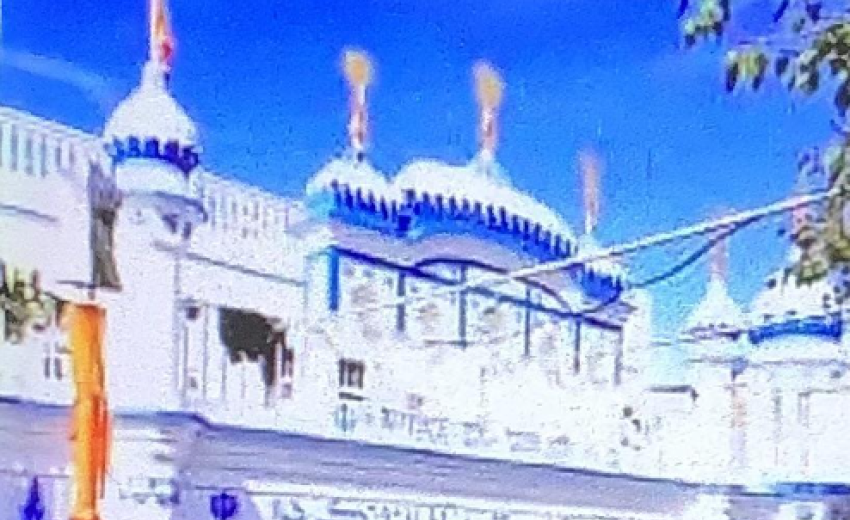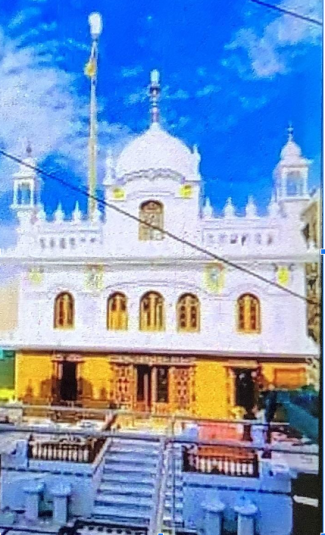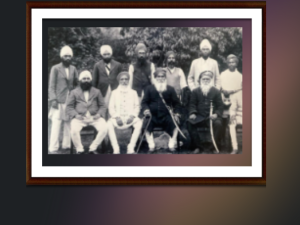Guru Nanak Dev ji visited Bhuj and Kutch around 1508 passed through the province of Sindh while going to Mecca and Medina. During this time, many Sindhi Hindus, Muslims and Sufis joined the Guru ji's preaching and darshans. Due to the clear message in Gurbani, almost all Hindu Sindhis got attached to Gurbani. The visit of Baba Srichand ji, which happened five years later, put a more firm stamp on this reality, but along with the influence of Gursikhi, Udasi sect and Sufism, Hindu idol worship also remained on the Sindhi Sikhs. Later, Sindhi Sikhs in Sindh ran Dharamshalas in which Gurbani was recited, studied, taught and sung. Sindhi Sikhs started coming to visit religious places like Nankana Sahib and Darbar Sahib Amritsar . In this way the Sindhi Sikhs began to harmonize with the mainstream Sikhs. The devotion of Sahajdhari Sindhi Sikhs to Gurbani is immense. I have personally observed this during my visit to Nankana Sahib Pakistan. These innocent Sindhis deserve our love and support. In the past, images of Sri Guru Granth Sahib were taken from Udasi and Sindhi centers. Until this time the Sindhi Sikhs were generally peaceful. The presence of Sehajdhari and Amritadhari Sindhi Sikhs in Sindh dates back to 1901. Bhai Sham Singh Ragi at Darbar Sahib Amritsar, started Amrit Prachar during his visits to Sindh.
Around 1927 during the Singh Sabha movement, Baba Thaharia Singh was sent by the Chief Khalsa Diwan to preach among the Sindhi Sikhs. They made Kandhra Nagar of district Sakhra their headquarters and with the support of Sant Gurmukh Singh Ji (Kar Seva) Patiala, Sant Sham Singh Ji Hazuri Ragi Darbar Sahib etc. These Gursikhs launched a vigorous campaign in Sindh province. It is said that the number of Sikhs in this area began to touch the number of thousands due to Baba Thaharia Singh's philanthropic personality. According to the census of 1901, the number of Sikhs in Sakhra district and surrounding areas was only around 1000. While in 1941 this figure crossed over 40000. Religious places were repaired in Ulhasnagar and surrounding areas. If we look at the religious practices of the Sindhi Sikhs, it can often be seen that Guru Nanak's unparalleled glory is given the most importance. The sound of 'Dhan Guru Nanak, Dhan Guru Nanak' often echoes in his every talk. This word of many Sindhi elders can be called Takiya Kalam.
As a result of this Sindhi Sahajdharis became Amritdharis and their number is increasing day by day. The marriage of Sahajdhari Sindhi Sikhs also takes place according to etiquette in the presence of Sri Guru Granth Sahib. In their mental phenomenon there is the phenomenon of Gurmati. Mainstream Sikhs should treat the Sindhis and Udasis with love so that they too can become a part of the Sikh mainstream.
Representatives of Dalit Sikhs are nominated to the Shiromani Committee, similarly Sindhi Sikhs must also be nominated at least one representative to the Shiromani Committee. One member of the Shiromani Committee represents about one lakh Sikhs. Therefore, one Sindhi Sikh should be nominated as a member because two lakh Sindhi Sikhs cannot be part of the election process as they are settled in many cities of India. Sadhu Vaswani, Chellaram and Kamala Bhainaji are highly respected in Sindhi society. The Sikh community greatly respects these personalities. They have a major center at KumarHatti in Himachal Pradesh. Near it is the center of Akhand Kirtani Jatha, both have a loving relationship . Gurbani is preached in the Sindhi Center of Kumar Hatti.
Among the Sindhis who came to India, Dada Chellaram settled in Delhi and established his ashram named 'Nij Town' on Pusa Road, Delhi. After his grandfather's death, his daughter Kamala took over the service of preaching and now grandfather's son Lachman Chelaram is interested in the preaching of Guru Nanak's faith. It has prepared literature of Sri Guru Granth Sahib Ji in Sindhi and Hindi and has ventured into inoculations in English, Gujarati, Bengali, Dev Nagri and Sindhi among other major languages of the country. It has also established 'Dada Chela Ram Ashram' at Saprun near Solan in Himachal Pradesh. They have also arranged to print Sukhmani Sahib Bani in exact Oriya, Telugu, Tamil and Roman script.
The Sindhis who settled in India were initially very close to Sikhism and established many Gurdwaras, but gradually these people are moving away from Sikhism even while expressing their full faith in Sri Guru Granth Sahib. They are content to call their gurudhams temples or ashrams instead of gurdwaras. By nature these people are gentle and calm. According to Dr. Ratan Singh Jaggi, author of Sikh Panth Encyclopedia, these Sikhs believe in spirituality but run away from fanaticism. With the establishment of the Shiromani Gurdwara Parbandhak Committee and after that with the entry of politics into this organization, they have started to consider their Gurdwaras (religious places) as non-safe. They are very alarmed by the fanaticism and ritualism developing in Sikhism. The tendency to keep Sehajdhari Sikhs away from the panth over the issue of votes has also prepared them to shun Sikhism. Although they are moving away from the structure of the Sikh Panth, they are moving very close to the Nirmala and Udasi sects. Sindhi Sikhs freely donate to schools and social service-oriented activities run by these sects. Big wealth shines in Sindhi Sikh homes. Children are named according to the etiquette of taking words from Sri Guru Granth Sahib Ji and marriages are performed with joy in the presence of Sri Guru Granth Sahib Ji. They have built many Gurdwaras in foreign countries as well. They have unlimited love for Guru - Ghar.
If the wind of bigotry continues like this, then as the rest of the sects have gone away, another large part of the sect will separate from it and its impact on the development of the nation will have serious consequences. This is happening because of the political pressure on the SGPC. The Shiromani Committee, all sect leaders and organizations should join hands and be united about the expansion and development of the Sikh Panth. Lovers of the Guru-ghar and those who are loyal to Nanak Naam Lewa should gather under one umbrella and say welcome with open arms. The manner in which the national power is being fragmented, there is a need to think about it and make a concerted effort. The SGPC should not miss the opportunity to represent the Sindhis . There are many aspects of religion today that need to be evaluated. It is a different thing that after the partition of 1947 these two areas namely Kutch and Bhuj came to be part of Gujarat. In this way, the number of Sindhi Sikhs of the Sindh province spread in the areas from 'Kutch' and 'Bhuj' to Karachi, Hyderabad was in several lakhs. They were also very proud to call themselves 'Sehajdhari Sikhs. Further, many close relations of these Sahajdhari Sikhs were also connected with Hindu families. So, due to the good conduct of Sikhs and the incredible sacrifices of the Sikh Gurus, most Hindu families also felt proud to call themselves 'Sehajdhari Sikhs'.
If we look at the census data of the entire Pakistani province of Sindh before 1947, then there was a population of about one and a half to two lakh Sindhi Sikhs in this area. It is a very surprising thing that when the country was partitioned, Hindus and Sikhs of the entire West Punjab migrated to this side of Punjab.
After the advent of the industrial revolution, these people had taken their business to the heights with great efforts. Therefore, because of the strong businessmen, good behavior and holding everyone's hand in happiness and sorrow, the common Muslims of the area are also grateful to them. As a result, according to the changed circumstances, most of the Hindu-Sikhs started migrating to India even though they didn't want to. The non-Muslim population in Sindh, which is about 25 percent, has been limited to only eight-nine percent today. If we talk about the Sikhs, eight to ten thousand Sikhs have remained in the Sindh area, while the rest have spread to other parts of the world apart from India. After December 1947, most of the Sindhi families left for the bordering states of Sindh, Gujarat, Rajasthan, Madhya Pradesh and Maharashtra.
Ulhasnagar, an area adjacent to Mumbai, has been kept as a special headquarters by the Sindhi Sikhs in recent times. The Gurdwara Guru Nanak Darbar here is becoming a center of special attraction among the Sikhs of the country and abroad. There is a population of about 25 to 30 thousand Sindhi Sikhs in Ulhasnagar area. The dawn pilgrimage dedicated to the birthday of Guru Nanak Dev Ji has set a world record. Under the leadership of Prabhat Feri, which is held every year in the month of November, a gathering of around two lakh devotees participates in the chanting of Dhan Guru Nanak, Dhan Guru Nanak. In addition to Ulhasnagar (Mumbai), Indore, Pimpri (near Pune) etc., the Sindhi society has established four centers in addition to Gurdwara Sahibs. Many of them are also big industrialists and factory owners who are able to hold the arm of our Sikh children in times of unemployment. Remember that the Sindhi Sikh community has had a close relationship with the local Hindu community since the beginning.
Due to mutual relations, this society is often influenced by each other due to the marriage ceremonies of boys and girls. Instead of imposing their rigid moral bonds on this community, our sect leaders should treat them with love, respect and compassion.
It should be taken together so that the relationship associated with these Sikhs from the time of the Gurus can be strengthened and the entire nation can become ready for future challenges together.







